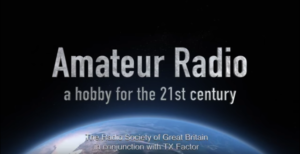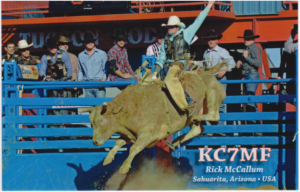Late entry from June 14, 2016
My son is a member of Troop 148 of the Grand Teton Council here in Southeast Idaho. His troop has an activity every Tuesday evening and frequent overnight camp-outs as well. On this past Tuesday afternoon I received a phone call from our Scout Master asking if I would talk to the boys about Amateur Radio.
After accepting the invitation I hung up the phone and paused to think about what I’d just done. Great Scott! I didn’t have anything prepared in advance. I was at work and the meeting time was shortly after work with very little time to prepare. The outcome of whatever I shared would likely result in the formation of new opinions or reinforcement of already formed opinions of what Amateur Radio is all about. I feel that Amateur Radio is a hobby, beloved pastime, means of preparedness and self sufficiency, vocation and continuous source of life long learning all wrapped up in neat little package and I was about to share that package with 7 – 10 boys aged 12 to 14. What ever I was about to say could have profound lifelong results in their lives.
On my drive home from work that evening it was time to make some quick decisions about what I was going to share and how I was going to do it. Most important was some hands-on activity with the radio equipment which would be fairly easy to do. I said a quick prayer for some good band conditions and to make an interesting contact. It also occurred to me that a good introduction would be important as well. This would be especially important if band conditions were bad and we were unable to make any contacts. So that set the format in my mind. I recalled a video that I’d s een on YouTube focusing on youth and their involvement in radio. So I planned to include that. Next, add a pinch of what amateur radio really is, contrast it to cell phones and internet then toss in a natural disaster and see which form of communications are still standing. But wait! How do I write a lesson plan for all of that in the short period of time that I had to prepare? The answer came to me and it was very simple! The answer was to “share what I love” and let my heart do the rest.
een on YouTube focusing on youth and their involvement in radio. So I planned to include that. Next, add a pinch of what amateur radio really is, contrast it to cell phones and internet then toss in a natural disaster and see which form of communications are still standing. But wait! How do I write a lesson plan for all of that in the short period of time that I had to prepare? The answer came to me and it was very simple! The answer was to “share what I love” and let my heart do the rest.
We met at our church at 7 PM. An impromptu game of “keep away” ensued. It was the boys vs the adults with an awesome super-ball in a basketball court. The ball was fast and was colored such that it blended in with the court floor and seemed to almost disappear as it was coming at you. We had quite a bit of fun. Shortly after that we gathered in a classroom, took part in some Scouting formalities and then the time was handed over to me.
The discussion started with how cell phones work, a little bit about the path that a cell phone’s signal takes when going from one participant of a conversation to the other participant on a cell phone in a conversation and everyone chuckled when I described that path for two people talking or texting each other from the same room. Then I added a disaster scenario that could disrupt communications for a small town or region and introduced Amateur Radio. I described how Amateur Radio brought communications for emergency services back to New York City immediately following 9/11 and the role that Amateur Radio Operators played following Hurricane Katrina. The boys were very interested and had a lot of good questions. Following this I played the first few minutes of the video I mentioned above. After the introduction of the video showing many different ways Amateur Radio can be used for fun I paused it and went into a little bit more depth about the kinds of things that can be done after getting an Amateur Radio license. We talked about fox hunts, working satellites, regular voice communications as well as digital modes. While talking about digital modes I touched briefly on the role amateur radio played in saving many of the crew members lives from the H.M.S. Bounty off the coast of North Carolina in October of 2012. There was a steady stream of enthusiastic questions. Our Scout Master and other Leaders were interested in learning more and very encouraging of the boys to do the same. The Scout Master tossed the option of the boys studying and preparing to take the FCC licensing exam to earn their Amateur Radio Operator licenses. Just about all of them were in agreement about setting that as a goal for this coming fall when the weather turns bad outside.
Following our classroom “chalk talk” we headed out to my truck and I fired up my radio. It was not long before we came across KC7MCH, Richard L McCallum down in Southern Arizona not to far from the Mexico border. KC7MCH was booming in on 14.300 MHz. I was able to contact him and explained that I was on the air with Troop 148. He was excited to hear from us  and took the time to talk to each of the boys and answer their questions. Pictured to the left is his QSLQSL Test Card. It was clearly evident that Richard felt the same level of importance in sharing our common hobby with these boys. It was interesting that KC7MCH shared several things with the boys during his QSOQSO - Has to do with a communication or conversation Questio... with them that I shared with them during the “chalk talk” in the classroom. This was not planned in any way, I’ve never spoken to KC7MCH ever in my life but the conversation could not have gone better had we choreographed every word. Thank You KC7MCH!
and took the time to talk to each of the boys and answer their questions. Pictured to the left is his QSLQSL Test Card. It was clearly evident that Richard felt the same level of importance in sharing our common hobby with these boys. It was interesting that KC7MCH shared several things with the boys during his QSOQSO - Has to do with a communication or conversation Questio... with them that I shared with them during the “chalk talk” in the classroom. This was not planned in any way, I’ve never spoken to KC7MCH ever in my life but the conversation could not have gone better had we choreographed every word. Thank You KC7MCH!
All in all, I felt like the evening was a true success. We finished a few minutes before 21:00 local time. Our Scout Master and other Leaders were interested in learning more and very encouraging of the boys to do the same. We had great time together and made an awesome contact. The only thing I wish I had done was to take a few pictures of the boys while they were operating.
My next step is to plan the lessons for teaching the boys the things they need to not only pass the FCC exams but to be responsible and effective operators.
73 to All!
KE7TVZ Signing Off.


Recent Comments